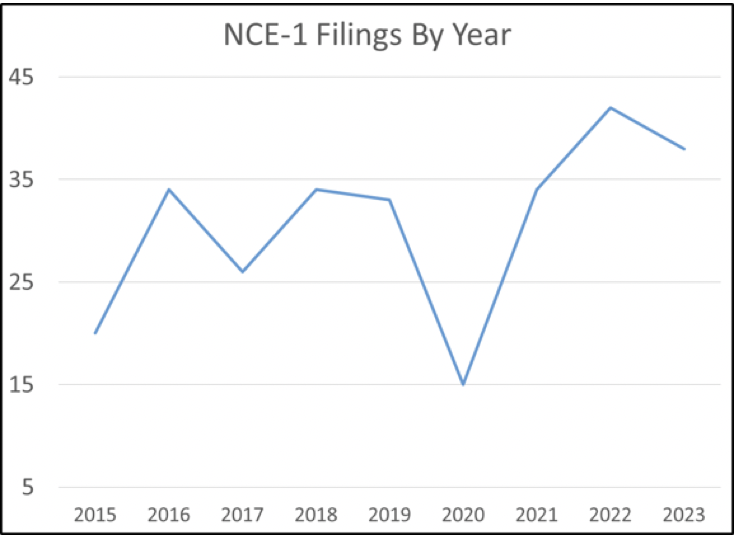“Several Federal Circuit decisions bemused Hatch-Waxman and biosimilar lawyers in 2020, none more so than GlaxoSmithKline LLC v. Teva Pharmaceuticals, Inc., which, if left to stand, would significantly tilt the playing field in favor of branded companies.”
 As we turn the page to 2021, we expect at least two major cases to be resolved that could have long-lasting effects on where and how Hatch-Waxman and Biologics Price Competition and Innovation Act (BPCIA) cases are litigated. Specifically, the future of skinny labels is in doubt, and available venues for Plaintiffs could be significantly narrowed.
As we turn the page to 2021, we expect at least two major cases to be resolved that could have long-lasting effects on where and how Hatch-Waxman and Biologics Price Competition and Innovation Act (BPCIA) cases are litigated. Specifically, the future of skinny labels is in doubt, and available venues for Plaintiffs could be significantly narrowed.
The number of new drugs eligible for generic competition will also rebound in 2021, but only time will tell if the global pandemic affects the overall number of generic filings. While there are many more Hatch-Waxman and BPCIA developments to watch this year, these are a few that we will be following closely.
The Future of Skinny Labels
Several Federal Circuit decisions bemused Hatch-Waxman and biosimilar lawyers in 2020, none more so than GlaxoSmithKline LLC v. Teva Pharmaceuticals, Inc., which, if left to stand, would significantly tilt the playing field in favor of branded companies. See 976 F.3d 1347 (Fed. Cir. 2020).
The U.S. Food and Drug Administration (FDA) has consistently allowed generics to omit indications and related information from its labels where such information does not affect the safe use of a drug. See 21 U.S.C. § 355(j)(2)(A)(viii). And the Federal Circuit has consistently found that such “skinny labels” do not induce infringement of method-of-use patents that cover such a carved-out indication. See, e.g., Warner-Lambert v. Apotex Corp., 316 F.3d 1348, 1360 (Fed. Cir. 2003); Allergan, Inc. v. Alcon Labs., 324 F.3d 1322, 1324 (Fed. Cir. 2003).
A Delaware jury found Teva liable for inducing infringement of a GSK patent directed to methods of treating congestive heart failure, despite the fact that Teva had carved the indication out of its generic carvedilol label. Chief Judge Stark, however, granted Teva’s post-trial motion to vacate the jury verdict, finding that Teva’s skinny label could not induce infringement as a matter of law. See 313 F.Supp.3d 582 (D.Del. 2018).
On appeal, the Federal Circuit reversed, finding that substantial evidence—such as Teva’s marketing materials touting its product’s AB rating—supported the jury verdict. See 976 F.3d at 1355-56.
While the fact pattern is unique amongst Hatch-Waxman cases, a holding that Teva’s skinny label induced infringement of GSK’s method-of-use patent would have far-reaching implications for generics, including an increase in patent barriers to generic market entry, and generic and biosimilar manufacturers may need to carefully craft any marketing materials that are presented to physicians and health care providers before and after a product is launched.
Teva petitioned for en banc rehearing on December 2, 2020, and more than ten amicus briefs have been filed to-date, including briefs filed by former Congressman Henry Waxman, and 57 law professors, to name a few. In the event the Federal Circuit does not grant en banc review, we expect Teva to file a petition at the U.S. Supreme Court.
Venue Limits for Hatch-Waxman and Biosimilar Cases
Another recent Federal Circuit decision likely to have wide-felt effects in 2021 is Valeant Pharma. v. Mylan Pharma., Inc., which is the latest case to apply the U.S. Supreme Court’s TC Heartland ruling to limit venue in Hatch-Waxman cases (and presumably, cases brought under the BPCIA). See No. 19-2402 (Fed. Cir. Nov. 5, 2020). There, the Federal Circuit held that “infringement occurs for venue purposes only in districts where actions related to the submission of the [abbreviated new drug application] ANDA occur, not in all locations where future distribution of the generic products specified in the ANDA is contemplated.”
Could we see the District of Maryland emerge as a new hotbed for Hatch-Waxman and BPCIA litigation? The Federal Circuit did not resolve the question of whether Maryland would be a proper venue based on the act of filing an ANDA or abbreviated Biologics License Application
(aBLA) at the FDA, but previously the court held that the act of filing an ANDA is insufficient for the Maryland district court to assert personal jurisdiction over a generic filer. See Zeneca Ltd. v. Mylan Pharma., Inc., 173 F.3d 829 (Fed. Cir. 1999).
Nor did the Federal Circuit’s holding disturb its precedent for venue determinations based on where a generic filer is incorporated or has place of business. As a result, we expect to see the overwhelming majority of Hatch-Waxman and BPCIA cases to be filed in Delaware and New Jersey in 2021.
Valeant filed a petition for en banc rehearing on December 7, 2020, with support from amici Pharmaceutical Research and Manufacturers of America (PhRMA). It will be interesting to see whether the full Federal Circuit chooses to stick with this narrowing venue holding, or if this case heads to the U.S. Supreme Court.
NCE-1 Filings Rebound
Most years see a steady stream of Hatch-Waxman and BPCIA cases, but 2020 was a low water mark in terms of the number of new filing opportunities for generic filers.
The Hatch-Waxman Act provides branded companies five years of data exclusivity for any product that contains a “New Chemical Entity” or “NCE.” See 21 C.F.R. § 314.108(a). The earliest date an ANDA can be filed for a generic version of such a drug is one year before the NCE exclusivity expires—which is referred to as the “NCE-1 date.” Because generic companies can target NCE-1 dates for their ANDA submissions, many NCE products garner up to 20 or more generic filers. In an odd coincidence that bore no relation to the pandemic, 2020 saw the lowest number of NCE-1 filing opportunities in several years.
 In a normal year, we would expect ANDA filings to similarly rebound with the number of NCE-1 filing opportunities. But many generic companies were forced to temporarily close at least some facilities during the pandemic. The lingering question is whether the pandemic caused significant interruptions in formulation development or bioequivalence studies that will impact generic filers’ ability to meet NCE-1 filing dates. If felt, such an impact would be most likely be seen in the first few months of 2021.
In a normal year, we would expect ANDA filings to similarly rebound with the number of NCE-1 filing opportunities. But many generic companies were forced to temporarily close at least some facilities during the pandemic. The lingering question is whether the pandemic caused significant interruptions in formulation development or bioequivalence studies that will impact generic filers’ ability to meet NCE-1 filing dates. If felt, such an impact would be most likely be seen in the first few months of 2021.
The return to a robust number of NCE-1 opportunities continues into 2022-2023, and we anticipate increased activity to pre-pandemic levels of generic filings in the late-2021 and subsequent years.
Image Source: Deposit Photos
Image ID:36623051
Copyright:jirkaejc

![[IPWatchdog Logo]](https://ipwatchdog.com/wp-content/themes/IPWatchdog%20-%202023/assets/images/temp/logo-small@2x.png)


![[Advertisement]](https://ipwatchdog.com/wp-content/uploads/2024/04/UnitedLex-May-2-2024-sidebar-700x500-1.jpg)
![[Advertisement]](https://ipwatchdog.com/wp-content/uploads/2024/05/Quartz-IP-May-9-2024-sidebar-700x500-1.jpg)
![[Advertisement]](https://ipwatchdog.com/wp-content/uploads/2024/04/Patent-Litigation-Masters-2024-sidebar-700x500-1.jpg)

![[Advertisement]](https://ipwatchdog.com/wp-content/uploads/2021/12/WEBINAR-336-x-280-px.png)
![[Advertisement]](https://ipwatchdog.com/wp-content/uploads/2021/12/2021-Patent-Practice-on-Demand-recorded-Feb-2021-336-x-280.jpg)
![[Advertisement]](https://ipwatchdog.com/wp-content/uploads/2021/12/Ad-4-The-Invent-Patent-System™.png)







Join the Discussion
One comment so far.
Xtian
January 26, 2021 09:35 amI have seen numerous articles on the GSK skinny label case. Most, like this one, gloss over the fact that Teva’s final, approved label did not carve out any indication. Rather the facts are that Teva did try to skinny label and carve out a patented indication in its initial ANDA filing. However, the FDA later required Teva to include all the approved indications in its label. Therefore, this case is not really about an ANNDA skinny label.
See excerpt from the Fed. Cir. Decision:
In 2011 the FDA required Teva to amend its carvedilol
label to be “identical in content to the approved [GSK
Coreg®] labeling (including the package insert and any
patient package insert and/or Medication Guide that may
be required).” Dist. Ct. Op. at 587. Teva amended its label
to include the indication for treatment of heart failure, as
required by the FDA. Dist. Ct. Op. at 587.